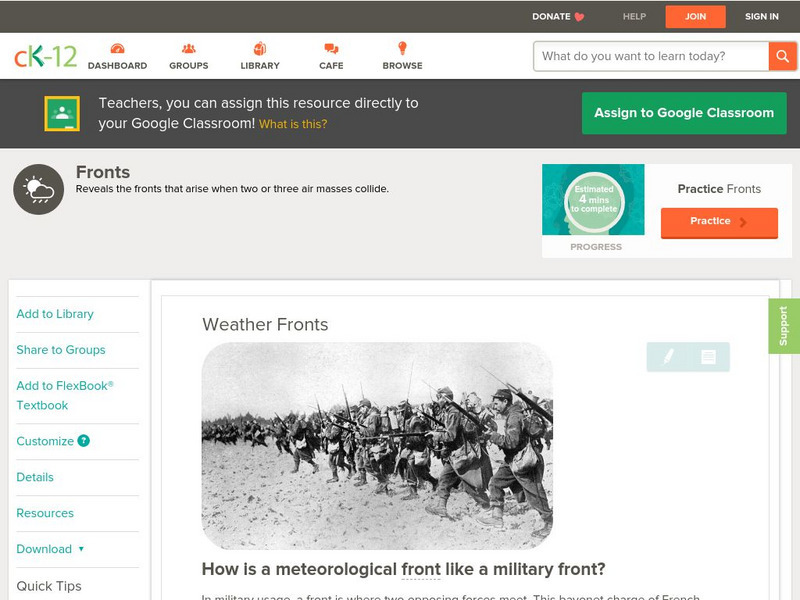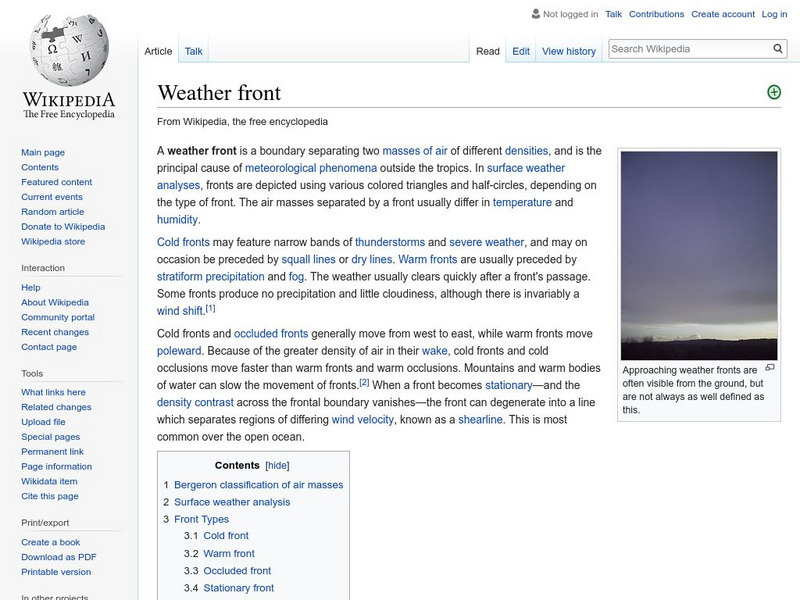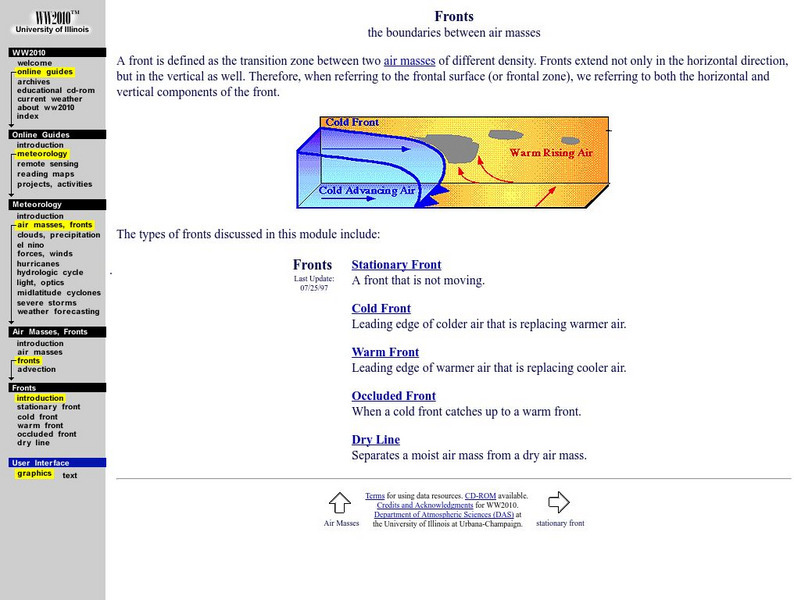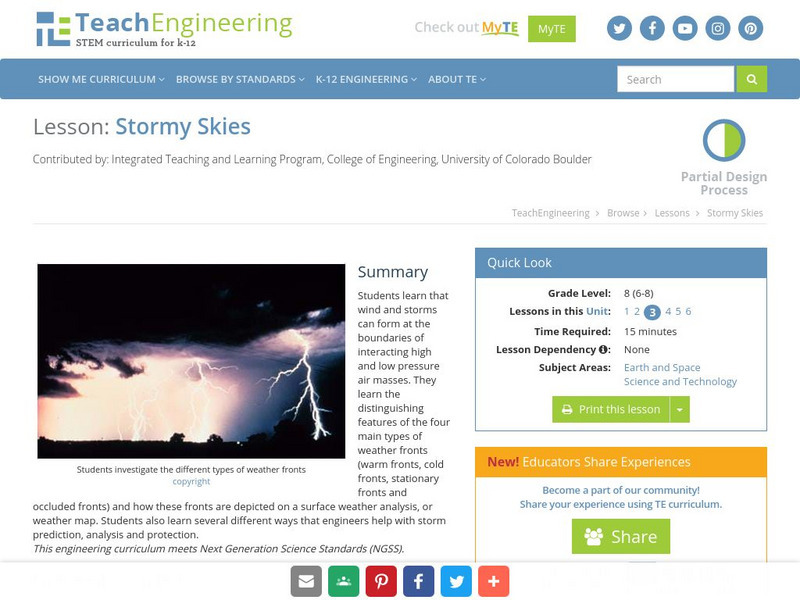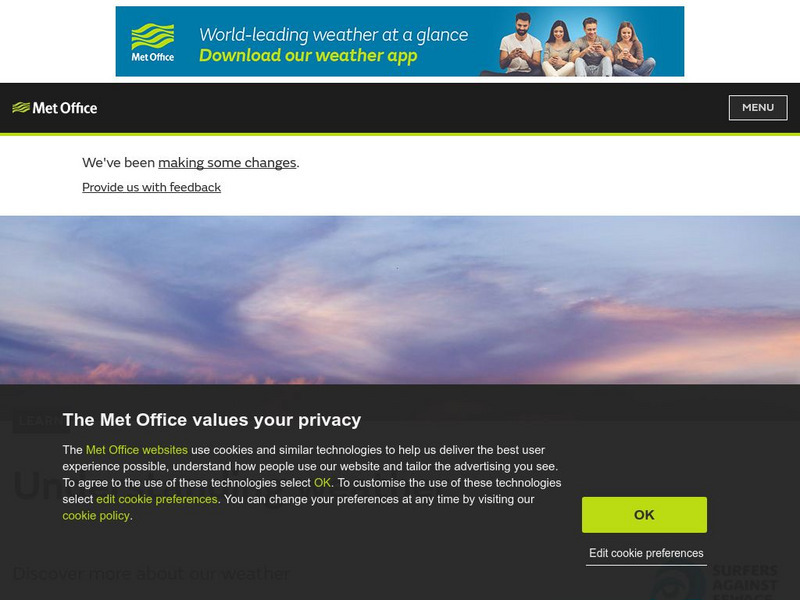Hi, what do you want to do?
Curated OER
Physics Post-Lab
Students explore physics. In this science instructional activity, students discuss physics in their everyday lives. Students complete a physics worksheet.
Curated OER
Cloud Painting
Students explore clouds and abstract thinking through painting. This lesson uses higher thinking skills and encourages self expression.
University of Illinois
University of Illinois Urbana Champaign: Air Masses and Fronts
What are air masses and where do they originate? What happens to the weather along fronts? Learn about warm and cold fronts and different types of advection. Maps and animated illustrations make these topics easier to comprehend.
Utah STEM Foundation
Utah Stem Action Center: Air Masses
An air mass forms when the air over a large region of Earth sits in one place for many days. The air gradually takes on the characteristics of the land or water below it. Where Earth's surface is cold, the air becomes cold. Where Earth's...
Scholastic
Scholastic: Study Jams! Science: Weather & Climate: Air Masses & Fronts
A video and a short multiple-choice quiz on the topic of air masses and fronts. It describes the types of weather fronts, what an air mass is, and the four types of air masses in the US.
University of Illinois
University of Illinois Extension: Ww2010: The Boundaries Between Air Masses
Describes the different types of fronts and the dry line associated with certain fronts. Well illustrated with diagrams and maps.
Other
Physical geography.net: Introduction to the Atmosphere
A very detailed description of air masses, how they move and interact, and what weather takes place when this happens.
Ministry of Education, Sports & Culture (Samoa) Government
Mesc: Samoa School Net: Forces to Make Weather: Weather & Water Cycle
Explains three forces of nature and how they impact the weather. These include infrared rays from the sun, differences in air pressure, and wind flow when hot and cold air masses meet. Supported by lots of visuals.
American Geosciences Institute
American Geosciences Institute: Cold Front and Warm Front
Read and understand the differences between a cold and a warm front.
CK-12 Foundation
Ck 12: Earth Science: Weather Fronts
[Free Registration/Login may be required to access all resource tools.] Describes the weather fronts that occur when two air masses collide. Includes downloadable handouts.
Wikimedia
Wikipedia: Weather Front
This Wikipedia site tells all about weather fronts, or boundaries between two air masses with differing characteristics. Includes many hyperlinked terms to additional information on related subjects.
Science Struck
Science Struck: Explanation of an Occluded Front With Diagram
Explains what an occluded front is and how it forms when three air masses interact.
University of Illinois
University of Illinois Urbana Champaign: Fronts
With the study of weather we need to know that there is air mass like fronts that change weather. This site shows us the different kinds of fronts that we experience.
CK-12 Foundation
Ck 12: Earth Science: Weather Fronts
[Free Registration/Login may be required to access all resource tools.] Describes the fronts that occur when two air masses collide.
ClassFlow
Class Flow: Weather Conditions
[Free Registration/Login Required] This flipchart is a beginning of a unit on weather. The flipchart contains information about fronts, air masses, and wind. There is an assessment quiz at the end.
American Geosciences Institute
American Geosciences Institute: Wind Classroom Activities
When air is warmed, it expands and becomes less dense. As the air becomes less dense, its air pressure decreases. This occurs because molecules in warm air have greater kinetic energy (energy of motion) than in cold air. As the molecules...
PBS
Pbs Teachers: Vanished: Inside the Jet Stream: Giving Rise to the Jet Stream
Explore what generates a jet stream, and discover why they flow from west to east. A link is offered in this site to a helpful animation describing the jet stream process.
University Corporation for Atmospheric Research
Ucar: Icy Winter Weather
When meteorologists forecast a winter storm one of the important predictions they make is the type, or types, of precipitation that are likely to fall. Will freezing rain cause an ice storm? Will ice pellets called sleet leave the ground...
Science Struck
Science Struck: Important Facts About the Stationary Front
Read about how a stationary air front forms when warm and cold air masses meet but neither can overpower the other. Explains what its characteristics are and the impact it can have on weather conditions.
CK-12 Foundation
Ck 12: Earth Science: Weather Fronts Study Guide
Review the main types of weather fronts using this study guide.
TeachEngineering
Teach Engineering: Stormy Skies
Learners learn that wind and storms can form at the boundaries of interacting high and low pressure air masses. They learn the distinguishing features of the four main types of weather fronts (warm fronts, cold fronts, stationary fronts...
University Corporation for Atmospheric Research
Ucar: Weather Images
Photos, diagrams, and other images related to weather.













